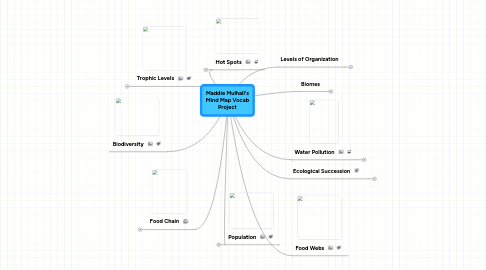
1. Trophic Levels
1.1. Producers (Autotrophs)
1.1.1. Produce their own energy.
1.2. Primary Consumers
1.2.1. Eat producers (1st degree consumer
1.3. Secondary Consumers
1.3.1. Eats 1st degree consumers (2nd degree consumers)
1.4. Tertiary Consumers
1.4.1. Eats 2nd degree consumers (3rd degree consumers)
2. Food Chain
2.1. Food chains show the sequence of energy transferred from one organism to the next as one eats the other.
2.2. Food Chain Rules: a. Focus on one ecosystem at a time b. Chose an organism at each level that would actually eat the one before it c. Always think about the direction the arrows should be going (where the energy is going)
3. Biodiversity
4. Population
4.1. Black Plague
4.2. Industrial Revolution
4.2.1. Advancements from this time period include: agricultural revolution, food production, medicine advances, sanitation advances, and nutrition advances
4.3. Exponential Growth
4.4. Sustainability
4.5. Logistic Growth
4.6. J-curve
4.7. S-curve
4.8. Population Growth Rate
5. Hot Spots
5.1. There are more than 17 regionsof hot spots that cover almost 2% of Earth's land area
6. Levels of Organization
6.1. Organism
6.1.1. Any form of life
6.2. Population
6.2.1. Group of the same species located in the same area.
6.3. Community
6.3.1. Populations of living organisms interacting with one another.
6.4. Ecosystem
6.4.1. Group of organisms interacting with living and nonliving things
6.5. Biome
6.5.1. Geographic region of Earth that is inhabited by a community of plant and animal species
6.6. Biosphere
6.6.1. Layer of soil, water, and air that sustains life
6.7. Biotic Factors
6.8. Abiotic Factors
7. Biomes
7.1. Rainforest
7.2. Temperate Deciduous Forest
7.3. Coniferous Forest
7.4. Desert
7.5. Tundra
7.6. Grassland/Savannah
7.7. Freshwater Biome
7.8. Marine Biome
8. Food Webs
9. Ecological Succession
9.1. Primary Succession
9.1.1. Events that cause this type include growth of the side of a volcano and a landslide
9.2. Secondary Succession
9.2.1. Events that cause this type include a fire and deforestation
9.3. Pioneer Species
9.3.1. Example: Lichen or moss
9.4. Climax Community
9.4.1. Example: Grasses in prairies of cacti in deserts
9.5. Limiting Factors
9.5.1. Examples: water, energy, shelter, sunlight, predators, food, minerals, nutrients, competition, disease, etc.
9.6. Carrying Capacity
9.6.1. Limiting factors control the amount of species in an ecosystem and keeps them at finite capacity, or carrying capacity
10. Water Pollution
10.1. Point Source
10.1.1. Ex: Factory or waste water treatement plant
10.2. Non-point Source
10.2.1. Ex: Fertilizer, pesticides, pet waste, motor oil, household hazardous wastes, and/or driving a car
